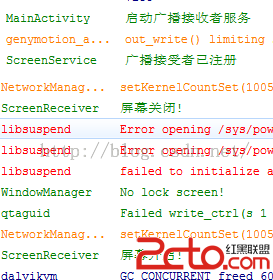編輯:關於Android編程
ImageLoader 這類的 圖片加載網絡上一大推,像比較出名的有nostra13 的-Image-Loader圖片加載,xUtil的圖片加載,還有 Facebook 的 Fresco 。很多,但本著求學的態度,最近在做項目時有圖片加載這個需求就自己寫了個輕量級的 (本地)圖片緩存加載 功能,分享給各位。
裡面涉及了 LruCache ,ExecutorService,處理大圖的 BitmapFactory 原理,view.setTag() .
好了,不多說,先一步一步來:
首先看一下我封裝的類怎麼使用:
// 本地照片絕對路徑
String imageUrl = (String) t;
// 得到 ImageView
ImageView grid_item = holder.getView(R.id.grid_item);
// 設置 tag ,標記用的,反正圖片顯示錯位
grid_item.setTag(imageUrl);
/**
* 顯示 圖片
*
* @param context
* : 上下文
* @param imageView
* : ImageView 控件
* @param sourcePath
* : 圖片 地址
* @param r_Id
* : 默認 圖片 id ,R.drowable.id;
* @param callback
* :圖片顯示 回調
*/
new ImageLoader().displayBmp(mContext,grid_item, imageUrl, R.drawable.img_bg,this);
是不是很簡單。
接下來具體分析 ImageLoader 這個類:
都知道手機的內存有限,不可能將所有的圖片都加進內存,所以android 提供了一個 LruCache 方法,用到的 算法 是 :近期最少使用算法 ,及在圖片不斷的加進緩存,最少使用的圖片也在不斷的移除緩存 ,從而避免的內存不夠的問題。
LruCache 的初始化代碼如下:
public ImageLoader() {
// 取應用內存的 8/1 作為 圖片緩存用
int cacheSize = maxMemory / 8;
// 得到 LruCache
mLruCache = new LruCache<String, Bitmap>(cacheSize) {
@Override
protected int sizeOf(String key, Bitmap bitmap) {
return bitmap.getByteCount();
}
};
}
/**
* 將圖片存儲到LruCache
*/
public void putBitmapToLruCache(String key, Bitmap bitmap) {
if (getBitmapFromLruCache(key) == null && mLruCache != null) {
mLruCache.put(key, bitmap);
}
}
/**
* 從LruCache緩存獲取圖片
*/
public Bitmap getBitmapFromLruCache(String key) {
return mLruCache.get(key);
}
LruCache 就像 HashMap 一樣 利用put 和 get 得到緩存的東西。
接著看 圖片的 具體加載,先把代碼貼出來:
/**
* 顯示 圖片
*
* @param context
* : 上下文
* @param imageView
* : ImageView 控件
* @param sourcePath
* : 圖片 地址
* @param r_Id
* : 默認 圖片 id ,R.drowable.id;
* @param callback
* :圖片顯示 回調
*/
public void displayBmp(final Context context, final ImageView imageView, final String sourcePath, final int r_Id,
final ImageCallback callback) {
final String path;
if (!TextUtils.isEmpty(sourcePath)) {
path = sourcePath;
} else {
return;
}
// 先 試著 從 緩存 得到 圖片 , path 作為 圖片的 key
Bitmap bmp = mLruCache.get(path);
if (bmp != null) {
if (callback != null) {
// 回調 圖片 顯示
callback.imageLoad(imageView, bmp, sourcePath);
}
// imageView.setImageBitmap(bmp);
return;
}
// 如果 bmp == null ,給 imageView 顯示默認圖片
imageView.setImageResource(r_Id);
// 啟動 線程池
threadPoolUtils.getExecutorService().execute(new Runnable() {
Bitmap bitmap = null;
@Override
public void run() {
// TODO Auto-generated method stub
try {
// 加載 圖片 地址 對應 的 縮略圖
bitmap = revitionImageSize(imageView, sourcePath);
} catch (Exception e) {
}
if (bitmap == null) {
try {
// 如果 縮略圖 沒加載成功 顯示 默認 設置的圖片
bitmap = BitmapFactory.decodeResource(context.getResources(), r_Id);
} catch (Exception e) {
}
}
if (path != null && bitmap != null) {
// 將 縮略圖 放進 緩存 , path 作為 key
putBitmapToLruCache(path, bitmap);
}
if (callback != null) {
handler.post(new Runnable() {
@Override
public void run() {
// 回調 圖片 顯示
callback.imageLoad(imageView, bitmap, sourcePath);
}
});
}
}
});
}
代碼不是狠多,主要就是 先從緩存加載圖片,當加載圖片為空時,再從手機的圖片地址加載圖片
bitmap = revitionImageSize(imageView, sourcePath);
加載緩存圖片就不多說了,看的也明白, mLruCache.get(key);就這麼簡單
具體分析 revitionImageSize() 這個方法吧:
public Bitmap revitionImageSize(ImageView imageView, String path) throws IOException {
// 得到 布局 ImageView 的 寬高
int img_width = imageView.getWidth();
int img_height = imageView.getHeight();
BufferedInputStream in = new BufferedInputStream(new FileInputStream(new File(path)));
BitmapFactory.Options options = new BitmapFactory.Options();
options.inJustDecodeBounds = true;
BitmapFactory.decodeStream(in, null, options);
in.close();
int height = options.outHeight;
int width = options.outWidth;
Bitmap bitmap = null;
int inSampleSize = 1;
// 計算出實際寬高和目標寬高的比率
final int heightRatio = Math.round((float) height / (float) img_height);
final int widthRatio = Math.round((float) width / (float) img_width);
// 選擇寬和高中最小的比率作為inSampleSize的值,這樣可以保證最終圖片的寬和高
// 一定都會大於等於目標的寬和高。
inSampleSize = heightRatio < widthRatio ? heightRatio : widthRatio;
// 調用上面定義的方法計算inSampleSize值
options.inSampleSize = inSampleSize;
options.inJustDecodeBounds = false;
in = new BufferedInputStream(new FileInputStream(new File(path)));
bitmap = BitmapFactory.decodeStream(in, null, options);
in.close();
return bitmap;
}
代碼我也寫了注釋了 ,一般在加載圖片時都有對圖片一定的壓縮處理避免OOM,所以上面的處理方法也是挺常見的,對要顯示 圖片 根據 imageview 控件大小進行一定的壓縮。
如果對 圖片壓縮處理不是很理解的朋友這麼我簡單解釋一下:
首先加載完圖片:
BufferedInputStream in = new BufferedInputStream(new FileInputStream(new File(path)));
然後:
options.inJustDecodeBounds = true;
再接著:
int height = options.outHeight; int width = options.outWidth;
這時候注意 程序並沒有把圖片真正的加載進來,options.inJustDecodeBounds = true;
這句在起作用,但圖片的寬和高 的信息我們卻得到了,就可以處理壓縮圖片了!
壓縮完圖片再:
options.inJustDecodeBounds = false;
重新得到壓縮後的圖片:
bitmap = BitmapFactory.decodeStream(in, null, options);
解釋完畢。
仔細看代碼的同學會發現 displayBmp() 方法裡面有個 回調參數:
回調接口如下:
/**
* 顯示圖片回調
*
* @author Administrator
*
*/
public interface ImageCallback {
public void imageLoad(ImageView imageView, Bitmap bitmap, Object... params);
}
具體實現是在顯示圖片的地方回調的:
/**
* 圖片 緩存回調
*/
@Override
public void imageLoad(ImageView imageView, Bitmap bitmap, Object... params) {
if (imageView != null && bitmap != null) {
String url = (String) params[0];
// 判斷 這裡的 url 是否 對應 imageView.getTag()
// 如果 將這句 判斷 去掉 那麼 就會出現 經常出現的 圖片 顯示 錯位 問題 !!!!
if (url != null && url.equals((String) imageView.getTag())) {
((ImageView) imageView).setImageBitmap(bitmap);
}
}
}
代碼注釋的地方也寫了,不太理解的同學可以私信交流,另外附上我 github github連接上的源碼,可以下載下了運行方便好理解:
為了你方便使用,在你的項目中添加如下依賴即可:
dependencies {
compile 'com.zts:imageloader:1.1.1'
}
 Android 四大組件學習之BroadcastReceiver四
Android 四大組件學習之BroadcastReceiver四
本節學習系統中特殊的廣播接收者。我們前面幾節不是說了,當廣播接受者一旦注冊到系統中,當系統發送的廣播和你注冊的廣播的action匹配時,系統就會啟動廣播接收者所在的進程。
 導入Android工程出現unable to get system library for the
導入Android工程出現unable to get system library for the
導入Android工程出現unable to get system library for the project 錯誤提示問題與現象:當向eclipse導
 FloatingActionButton增強版一個按鈕跳出多個按鈕第三方開源之FloatingActionButton
FloatingActionButton增強版一個按鈕跳出多個按鈕第三方開源之FloatingActionButton
FloatingActionButton項目在github上的主頁:https://github.com/futuresimple/android-floating-ac
 Android 馬賽克(Mosaics)效果
Android 馬賽克(Mosaics)效果
前幾天看見開源項目效果好贊,看了下代碼,實現大致就是在原界面之上覆蓋一成自定義的View,獲取到點擊的那個View的內容(Bitmap),然後在覆蓋的那個自定義View的